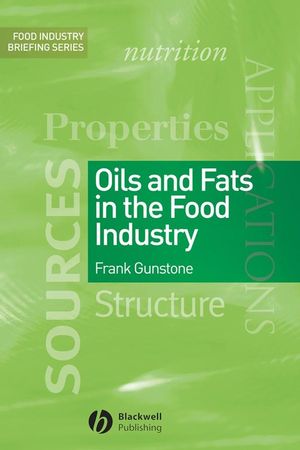Oils and Fats in the Food IndustryISBN: 978-1-4051-7121-2
Paperback
160 pages
August 2008, Wiley-Blackwell
 |
||||||
1.1 Fatty acids.
1.2 Triacylglycerols.
1.3 Ester waxes.
1.4 Phospholipids.
1.5 Sterols and sterol esters.
1.6 Tocols.
1.7 Hydrocarbons.
Chapter 2. The Major Sources of Oils and Fats.
2.1 Introduction.
2.2 Animal fats (butter, lard, tallow, chicken fat, and fish oils).
2.3 Cocoa butter and cocoa butter alternatives.
2.4 Lauric oils (coconut, palm kernel).
2.5 Olive oil.
2.6 Palm oil.
2.7 Rapeseed (canola) oil.
2.8 Soybean oil.
2.9 Sunfl ower seed oil.
2.10 Other vegetable oils.
2.11 Single cell oils.
Chapter 3. Extraction, Refining, and Modification Processes.
3.1 Extraction.
3.2 Refining.
3.3 Modification processes.
3.4 Blending.
3.5 Fractionation including winterisation and dewaxing.
3.6 Hydrogenation.
3.7 Interesterification using a chemical catalyst.
3.8 Interesterification using an enzymatic catalyst.
3.9 Domestication of wild crops.
3.10 Oilseeds modified by conventional seed breeding or by genetic engineering.
3.11 Animal fats modified through nutritional changes.
Chapter 4. Analytical Parameters.
4.1 Introduction.
4.2 Oil content.
4.3 Unsaturation – iodine value.
4.4 Saponification – free acids, sap value.
4.5 Melting behaviour, solid fat content, low temperature properties.
4.6 Oxidation – peroxide value, anisidine value, stability, shelf life, stability trials, taste panels.
4.7 Gas chromatography.
4.8 Near-infrared and Fourier transform infrared spectroscopy.
4.9 1H NMR spectroscopy.
4.10 13C NMR and 31P NMR spectroscopy.
4.11 Mass spectrometry.
Chapter 5. Physical Properties.
5.1 Polymorphism, crystal structure, and melting point.
5.2 Alkanoic and alkenoic acids.
5.3 Glycerol esters.
5.4 Ultraviolet spectroscopy.
5.5 IR and Raman spectroscopy.
5.6 Nuclear magnetic resonance spectroscopy.
5.7 Mass spectrometry.
5.8 Density.
5.9 Viscosity.
5.10 Refractive index.
5.11 Solubility of gases in oils.
5.12 Other physical properties.
Chapter 6. Chemical Properties.
6.1 Hydrogenation.
6.2 Atmospheric oxidation.
6.3 Thermal changes.
6.4 Reactions of the carboxyl/ester function.
Chapter 7. Nutritional Properties.
7.1 Introduction.
7.2 EFA and fatty acid metabolism.
7.3 De novo synthesis of saturated acids.
7.4 Desaturation and elongation in plant systems.
7.5 Desaturation and elongation in animal systems.
7.6 Antioxidants.
7.7 Cholesterol and phytosterols.
7.8 Conjugated linoleic acid.
7.9 Diacyglycerols.
7.10 Recommended intake of fats and of fatty acids.
7.11 Role of fats in health and disease.
7.12 Obesity.
7.13 Coronary heart disease.
7.14 Diabetes.
7.15 Inflammatory diseases.
7.16 Psychiatric disorders.
7.17 Cancer.
Chapter 8. Major Edible Uses of Oils and Fats.
8.1 Introduction.
8.2 Spreads – butter and ghee.
8.3 Spreads – margarine, vanaspati, and flavoured spreads.
8.4 Baking fats and shortenings.
8.5 Frying oils and fats.
8.6 Salad oils, mayonnaise and salad cream, French dressing.
8.7 Chocolate and confectionery fats.
8.8 Ice cream.
8.9 Incorporation of vegetable fats into dairy products.
8.10 Edible coatings.
8.11 Emulsifying agents.
8.12 Functional foods.
8.13 Appetite suppressants.
References and Further Reading.
Useful Websites.
Index.



